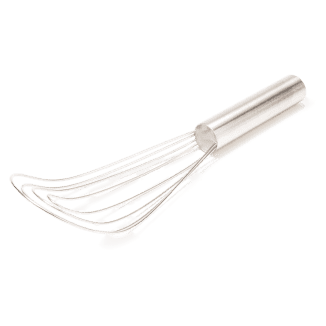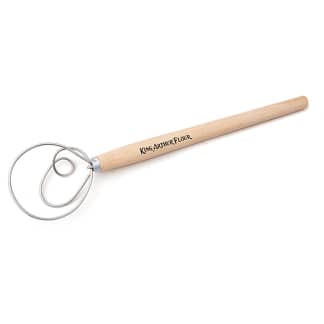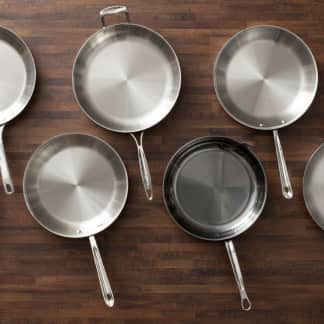The best flat whisks make it a breeze to produce great gravies and sauces. Our longtime favorite is the OXO Good Grips Flat Whisk. Its moderately stiff metal tines are arranged in a relatively flat profile, so it’s great at scraping up fond and mixing ingredients, and it maneuvers nimbly around skillets and saucepans. If you’d like a flat whisk for use with nonstick cookware, we also recommend the Cuisipro Silicone Flat Whisk—10 inch. Its silicone-coated tines are a little more flexible and more widely spaced than our top choice, so it’s not as adept at scraping up food. But it’s still useful for gently combining and emulsifying ingredients and keeping sauces from getting lumpy or accumulating on cookware.

An all-purpose whisk is our first choice for whipping, beating, mixing, emulsifying, and blending wet and dry ingredients. But the humble flat whisk has its place in our utensil crock too. Sometimes called a gravy or roux whisk, the flat whisk excels at helping you produce any kind of sauce that you might make in a skillet or saucepan. Its tines are arranged in a slim, snowshoe-like profile that’s easy to press against a cooking surface. This makes the flat whisk ideal for scraping up fond and emulsifying butter into liquid when making a pan sauce in a skillet. It’s also great for keeping thick, creamy sauces such as béchamel or cheese sauce from sticking to the sides of a saucepan or saucier, where they might scorch. That slim profile comes in handy, too, when you want to mix ingredients in a tight space such as a liquid measuring cup or a small saucepan without adding air or splashing those ingredients around.

What Type of Flat Whisk Should I Get?
There are two main types of flat whisks. One type has plain metal tines (loops) and is meant for use with metal cookware (stainless-steel, carbon-steel, and cast-iron pots and pans, among others.) The other type has metal tines that are coated in silicone. This type is best for use with nonstick cookware; the flat whisk’s silicone-coated tines will not scratch or damage the nonstick coating. Because those silicone tines are slippery and often less rigid than plain metal variants, these nonstick-friendly flat whisks can be a little harder to use for scraping (see below), so we don’t recommend them for use with other types of cookware. (Silicone flat whisks are appropriate for nonstick cookware since there’s never any fond or sticky bits that need scraping to begin with; the whisk is useful mostly for incorporating or emulsifying ingredients.)
What to Look For
- Relatively Flat, Moderately Wide Profile: We preferred flat whisks with tines that were fairly flat, as their name requires. These were the nimblest and easiest to maneuver, ideal for pressing against a skillet or saucier for scraping, and they kicked up very little sauce as we stirred too. We also preferred whisks that measured about 2.5 inches across the widest points of their outer tines. Narrower whisks didn’t cover as much ground as quickly, and wider whisks sometimes felt a bit less precise and agile.
- Even, Closely Spaced Tines: All the flat whisks we tested had four tines, but the spacing between the tines differed significantly. We preferred whisks with relatively small, even spaces between their tines, as these ensured good coverage when scraping fond and sauce off the surface of a pan—no area went untouched.

- Moderately Rigid Tines: We preferred whisks with tines that were just stiff enough to scrape fond or clumps of béchamel up without tiring our hands.

- Large, Grippy Handles: The handles on all the flat whisks were oddly short, which took us a little closer to the heat than we’d have liked. But the better models had handles that were relatively thick and made it easier to hold. In addition, our favorite model’s handle was made from a rubbery material that was especially comfortable to grip even when our hands were wet.
What to Avoid
- Curvy Profile: We didn’t love whisks with curved, upturned tines. Resembling shoehorns more than snowshoes, these curvy whisks weren’t flat enough to provide the kind of coverage we wanted when scraping fond off skillets, and they maneuvered more awkwardly around the curved walls of the saucier too. The upturned tines also splashed liquid around a bit more as we navigated different cookware.
- Tines with Large Gaps Between Them: Whisks with big gaps of ¾ inch or more between their tines occasionally allowed big lumps of roux to slip through intact and offered poorer pan coverage overall.
- Floppy or Ultra-Rigid Tines: Tines that were too floppy didn’t give us enough resistance against fond or clumps of béchamel, so we had to work harder to scrape up those bits. Whisks with tines that were too rigid made our hands ache when we had to use them for extended periods.
How We Tested
The Tests
- Make béchamel in a 4-quart saucepan
- Make pan sauce from Pan-Roasted Chicken Breast with Sage-Vermouth Sauce in 12-inch stainless steel skillet
- Have five users of different hands sizes and dominant hands test
- Bend tines 50 times
- Wash by hand or in the dishwasher 10 times
How We Rated
- Performance: We rated the flat whisks on how well they mixed and scraped.
- Ease of Use: We evaluated the models on how comfortable they were to hold, maneuver, and clean.















